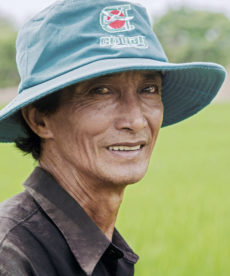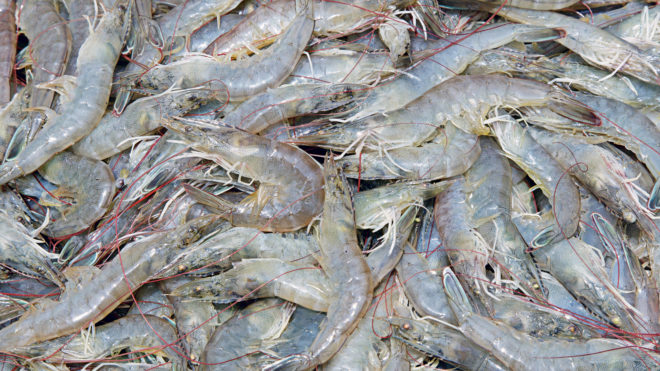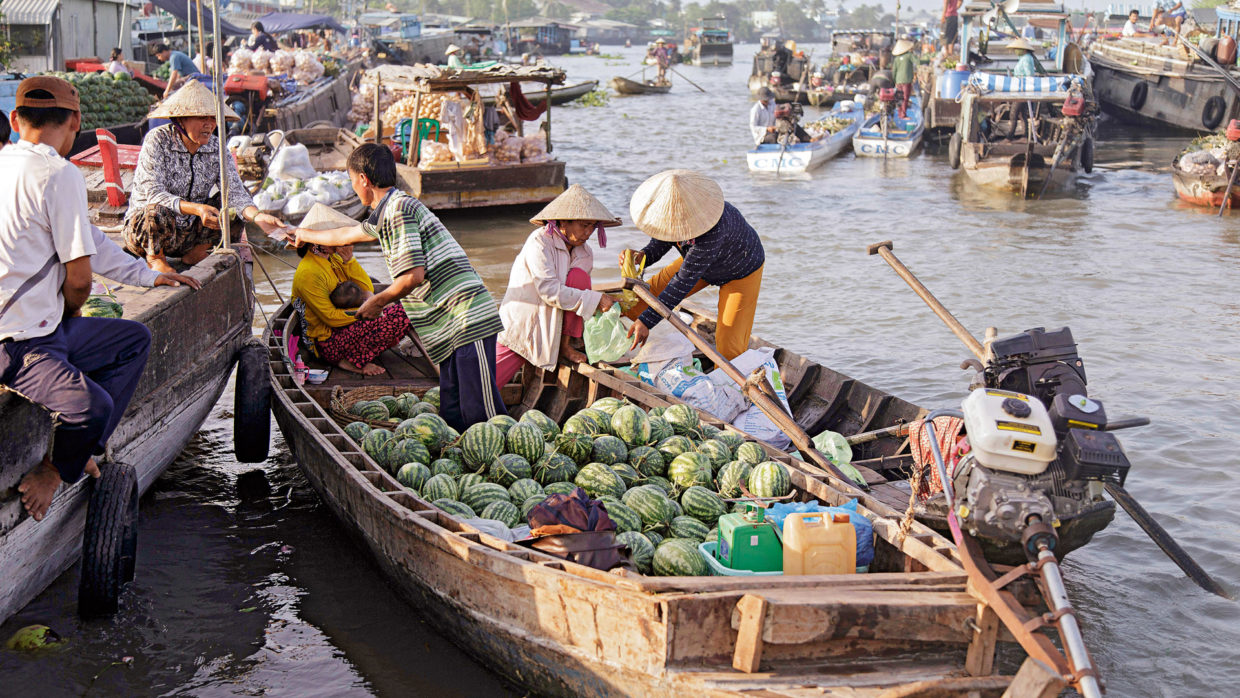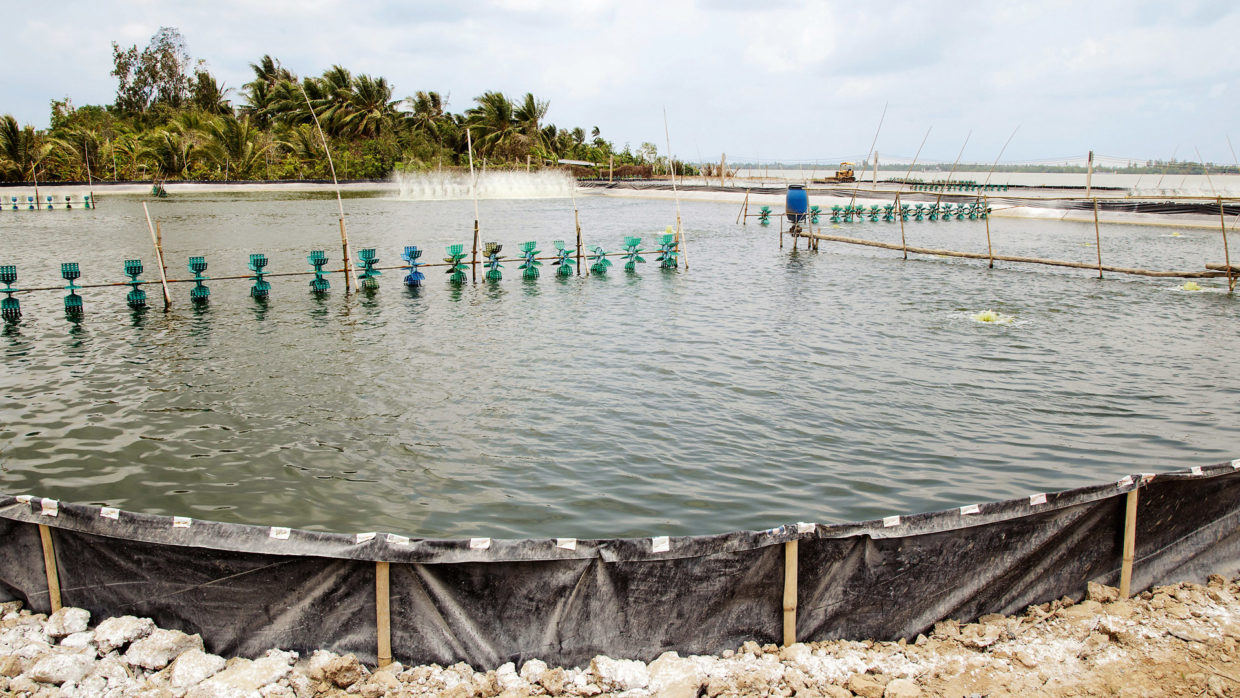For Phan Van Hom money really does nearly grow on trees. “Currently I get the equivalent of two dollars for two kg of mangos.” Inspecting the tree tops as he goes along, the farmer walks barefoot through the still wet grass. The morning traffic heading to Can Tho can be heard in the distance. Although it’s only 10km away, the largest city of the Mekong Delta seems far away. An old boat rattles along the small canal on which water hyacinths are growing. Birds twitter. A cock crows. “Previously there was only forest here with a few wild mango trees,” the 46 year-old tells us.

Phan Van Hom, mango farmer
Today the landscape is a patchwork of small orchards and irrigation ditches. The predominantly small farms feed the farmers well. “A mango tree can bring in more than $200 a year.” Phan Van Hom has 40 of them. He climbs up the ladder to trim a few shoots, one or two fruits are also still hanging in the tree. He carefully passes them to his wife, who places the mangos in a red plastic basket. “Previously we also had oranges and bananas, but no other fruit is so sought after countrywide than the mango.”
A mango tree can bring in more than $200 a year.
Phan Van Hom
Phan Van Hom must surely know this, as he not only grows but also trades fruit. He regularly travels with his delivery van to Hoh Chi Minh City to deliver to the markets there. All in all the family earns around $10,000 per year, which is four times the salary of an office administrator or teacher. “We also work very hard,” says the fruit farmer, moving his ladder to the next tree.
Fascinating diversity
Not least due to the industrious nature of its people, Vietnam has seen considerable economic growth of nearly 6%, even right after the financial crisis of 2008. The country’s many farmers are also benefiting from this. The growing middle class and many food varieties of the South East Asian country provide plenty of demand. Vietnam’s markets and the famous floating markets in the Mekong Delta offer a fascinating array of fruit and vegetables, including okra, lotus root, water spinach, guavas, lychees and dragon fruit.
Then there is the booming export sector. Vietnam is the second largest producer of coffee and pepper in the world. 6m tonnes of rice were exported by the South East Asian tiger economy last year and shrimps to the value of $3.6bn. Then there are the huge quantities of fish, particularly basa fish and tilapia, from aqua-farming.
Much of this comes from the Mekong Delta, with its nearly 3m hectares of land for agriculture and aquafarming. The region accounts for 30% of the country’s total agricultural area, more than the total size of Denmark, for example. The Mekong Delta supplies more than half the aquafarming products and around 70% of Vietnam’s yield in fruit. With 24m tonnes of rice produced each year in the Mekong Delta, this accounts for more than 50% of Vietnam’s total rice production. 90% of the exported rice comes from the estuary area of the nearly 4,500km long river.
Agriculture under pressure
The Mekong Delta is therefore one of the most fertile regions in the world. But for how much longer? Climate change and the associated rising sea levels, large-scale forest destruction, exploding levels of shrimp farming and heavy encroachment on the course of the river threaten the production of foodstuffs in the delta. One who has been warning about this for years is agronomist and environmental scientist Duong Van Ni from the University of Can Tho. “At the southern tip of Vietnam, in the Ca Mau Province, the land previously grew a few metres towards the sea every year, but now the land is being destroyed from erosion due to a lack of mangroves,” explains the researcher, who has been studying the region for 30 years.
At the southern tip of Vietnam, the land previously grew a few metres towards the sea every year, but now the land is being destroyed from erosion due to a lack of mangroves.
Duong Van Ni
In the last 15 years, 80% of mangrove forests in south Vietnam have fallen victim above all to shrimp farming. And in the upper part of the Mekong, nearly three quarters of the forests have been chopped down in the last 20 years. Water which once seeped away there now flows into the Mekong system and increases the water levels, which leads to more erosion. The large-scale excavation of sand for the construction industry exacerbates the phenomenon. Furthermore, China and other neighbouring countries are pushing to build large dams at the top of the river course. This could have serious consequences for the entire catchment area, such as the absence of seasonal floods.
Some farmers in the Mekong Delta are losing land due to these factors. Many more are also having to deal, in particular, with the salinisation of their soils. On the one hand due to the increasing sea level, and on the other hand due to the deepening of the river bed, heavier salt water can gradually move further up the Mekong below the fresh water flowing downstream. Even shrimp farmers sometimes have problems with salt, but it is rice and fruit farmers who are most affected.

In the Mekong Delta region 90% of Vietnam’s rice exported to foreign countries is grown.
As with mango farmer Phan Van Hom, Nguyen Ngoc Van from the village of An Lac Tay has also created a moderate level of affluence for himself. At his home he has a TV and two refrigerators. In his cupboard hang a considerable number of nice shirts. For his visitors he puts a fan on the veranda. It is extremely hot. “Much has got better,” says his mother, offering home-made sweets made from bananas, peanuts, ginger, sesame and lots of sugar. “Traders come and buy our rice; we produce for a global market and get better prices.”
But over the past few years the family had to face crop losses because the water from the tide-dependent irrigation canal was too salty, even though the coast is nearly 100km away. Several of the three harvests a year did not yield anything. “One harvest less means there isn’t enough money to buy seed and fertiliser for the next harvest, so then we need to borrow from the bank,” explains her son.
Salinisation is the biggest problem

Le Van Loi is growing lychees on half his land.
Walking to his field, Nguyen Ngoc Van points out the irrigation canal and the small watergate he uses to flood his 0.5ha of land. He hunkers down on the small dam and looks at the light green area. In the neighbours’ adjacent fields, the workers are walking through the rows of small rice plants and pulling out weeds. What they will get from this harvest, they don’t know. “We actually always leave the watergate open for 100 days and then close it, harvest and plant anew.” However, Nguyen Ngoc Van recently discovered crystals of salt at the pillar of the small bridge in the village and closed the watergate as a precaution.
With a rice yield of 10t/ha, the yields from the soils of the Ke Sach district are actually comparatively high for Vietnam. However, the problems have been gradually increasing for a few years. This is also confirmed by the other farmers who come to join us from the fields. Even neighbour Le Van Loi, who grows lychees on half his land, reports there being salt on his low-lying areas.
“First the leaves of the trees turn yellow, then they fall off early,” he says, folding his arms behind his lean upper body. “The trees don’t die but they bear a lot less fruit.” He had actually switched to lychee growing because it was supposed to bring higher yields and be less work. Now he is worried about his 700 trees.
With a 2004 map of the soil salt content, we travel further through villages that 10 years ago did not have any problems, to talk to other farmers. People are working in the fields and orchards everywhere. The answers we get are varied. One farmer has lost some of his banana trees due to salinisation, and a rice grower has lost his entire harvest. Others shake their head when asked about problems. Duong Van Ni from the University of Can Tho tells us the problems are not happening to the same extent everywhere.

Manual labour is the traditional and still common way of planting melon seeds.
Sustainable shrimp farming
Heading towards the southern tip of the country, the landscape becomes more and more sparse. Canals and roads intersect the swampy land. Orchards are no longer to be seen, and there are all the more rice fields. Harvesters work their way through the golden yellow crops. Bulging sacks filled with rice stand on the roadside waiting to be transported away. Children fly kites on the fields of stubble, before these are burnt.
After the “American war” – which is how they refer to the Vietnam war here – ended in 1975, the government of the reunited country had parts of this coastal region dyked for rice farming. However, there are now more and more shrimp farmers moving inland from the coast. You can recognise the farms from the rows of small paddle wheels attached to rods and turning on the water’s surface over the farming basins. They are providing oxygen to the basins lined with tarpaulin. With 150 shrimps per square metre these are densely packed. Conventional farming with the use of pellet feed and medication brings an average shrimp yield of 15t/ha.

Global Demand for the grey protein-rich crustaceans continues to be high.
The shrimp farm of Nguyen Thi Tuyet and her husband works quite differently. In order to get there you have to take a long journey by boat through rivers and canals, passing mangroves and wooden houses on stilts. The organic farm is 2.7ha in size and two-thirds of that are home to mangroves.
Mangrove as shrimp feed

Together with her husband, Nguyen Thi Tuyet moved from northern Vietnam to the Mekong Delta to establish an organic shrimp farm.
The certification under the requirements of the WWF-initiated Aquaculture Stewardship Council (ASC) for sustainable aqua-farming prescribes that at least half the land should be occupied by mangroves to serve as coastal protection and biofeed. The leaves of the mangroves fall in the water and the phytoplankton that form as a result of this serve as food for the shrimps. “Other food or medication is not necessary.”
Nguyen Thi Tuyet sits on the wooden planks of the veranda of her house and pours green tea into small cups. It is true that the organic shrimp farmers only harvest 1t/ha of shrimps, but because they sell these to the German organic company Binca via a Vietnamese distributor they get the equivalent of around $10/kg, which is a good price. “Since we gave up our rice farm in the North near Hanoi to start a shrimp farm down here, life has gone steadily uphill.” Nguyen Thi Tuyet nods with satisfaction. With her annual income of around $10,000 she can even pay for her two children who stayed in Hanoi to go to university.
Local solutions are needed
If there were a larger number of these shrimp farms, the depletion of the mainland at Vietnam’s southern tip might stop. However, this hardly goes for all the changes in the delta region being caused by humans, which are putting more and more farmers into difficulty. Duong Van Ni from the University of Can Tho suggests some concrete measures to take.
The alarm must be raised not just in Vietnam
Duong Van Ni
“We need to act locally now,” says the scientist. For example, he and his team have developed a monitoring system to warn farmers by text message when the salt content in their water is too high. Then they can close the watergates of their irrigation canals in good time. Salt-resistant rice varieties could also be important. “The alarm must be raised not just in Vietnam,” urges the scientist. However, the farmers in the Mekong Delta cannot wait for global climate protection measures to be put in place. Otherwise the money won’t grow on trees any more.



